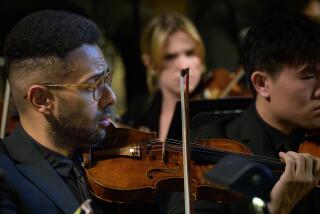A Sampling of the Emigre Experience
In tandem with the âExiles and Emigresâ exhibition at the Los Angeles County Museum of Art, the museumâs Monday Evening Concerts series took a look back to its storied associations with emigre composers. And who better to curate the event than pianist Leonard Stein, who appeared on the first installment of the series in 1939.
Seven compositions in all were presented by MEC Ensembles in Bing Theater, five by composers who settled locally. Little sense of unity was attempted in the lengthy agenda, but that was in keeping with the series, which has always been a sampler.
A group of Hanns Eisler songs best expressed one view of the emigresâ lot in Southern California. His Hollywood Elegies on texts by Bertolt Brecht are a biting take on the movie-town culture, where artists âgo to the market where lies are sold.â In another Hollywood Elegy on his own text, Eisler laments the fate of his friend and fellow emigre Peter Lorre, whom he sees as sunk in the Hollywood swamp.
Schoenbergâs Andante Grazioso from his Violin Concerto (arranged for piano and violin) connected strongest with the exhibition itself. In it, we recognize the old forms of violinistic discourse transformed by the 12-tone method, a musical analog to emigre Max Beckmannâs tradition-twisting paintings.
Also heard were Stravinskyâs Four Songs on phonetic Russian texts for voice, flute, harp and guitar, given its premiere at MEC in 1955; Ernst Tochâs episodic, chromatical âProfilesâ for piano; and Ernst Krenekâs modal, dusky Harp Sonata. From the New York contingent came Stefan Wolpeâs Trio in Two Parts, a severe exercise in capillary counterpoint and Bartokâs âContrasts,â originally written for Benny Goodman.
Among the stalwart performers were Stein, pianist Delores Stevens, violinist Margaret Batjer, harpist Susan Allen and soprano Jacqueline Bobak.
More to Read
The biggest entertainment stories
Get our big stories about Hollywood, film, television, music, arts, culture and more right in your inbox as soon as they publish.
You may occasionally receive promotional content from the Los Angeles Times.










